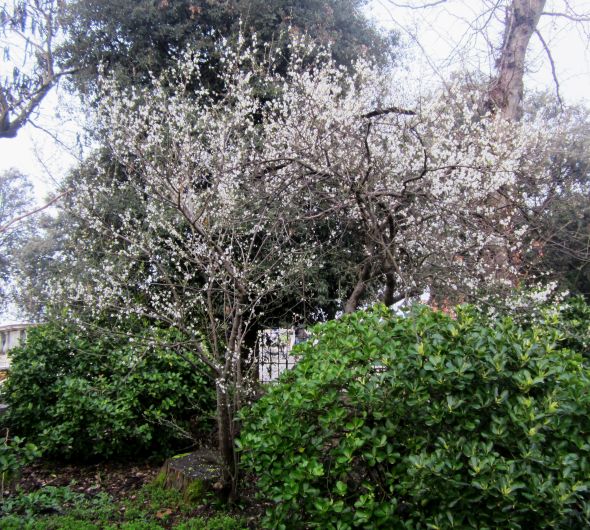
Veteran readers are all too aware of my passion for watching for the First Signs of things — mostly from the natural world. Yes, confetti counts.
Venice has had a totally boring winter. It hasn’t even really been winter. The temperature may have gone just barely below zero once or twice, but it would have been at night and I didn’t notice. We could practically have turned off the heat (thereby foiling the vampires of the gas company who suck whatever financial blood we manage to build up). But that would have encouraged mold and the smell of damp.
For the record, there was acqua alta a few times, but it wasn’t dramatically high, nor dramatically frequent.
I do feel sorry for everyone who has had to endure the apocalyptic winter which has struck much of the US and Europe But for us here, it’s been some fog, some rain, some more rain, a little more fog, and that’s about it.
Therefore it was only a small surprise to discover that the demure little plum tree (Prunus domestica) near the Giardini decided it was time to bloom. It’s pretty unusual to see blooms in late February, but there they were. Early? Late? Blossoms don’t tend to pay attention to that. There have been violets on the lawn at the Morosini Naval School for a week already.
I hope that March doesn’t play one of its amusing little meteorological tricks on the flowers and leaves. Whatever this season could be called, it’s time for it to move on and make room for another season to have a chance. Perhaps the plum blossoms are just one of nature’s ways of hinting that it’s time for winter to go home.

3 Comments
I feel for your doldrums, Erla. Life, connected so closely to the weather, can get that way at times. But remember there are worse things than boredom, which is mostly a creation of the bored, and serves as a precursor of revelation.
The winter other places has indeed been somewhat unprecedented, but as is true with everything shared publicly these days, alarmingly distorted by the media. What’s with all these sensationalist new terms, like “Polar Vortex”, or “Derecho” (the lines of storms that swept across the U.S. a couple summers go)? The weather scientists, in spite of their pretensions, do not understand what the hell is happening and so must obfuscate their confusion, and then the media anthropomorphizes nature, giving it murderous intent. Really?
What severe weather dramatizes is many people’s ill-advised priorities in a society driven almost solely by money, putting some manic need to get out and conquer the conditions to get to work or buy potato chips and beer over common sense and personal safety. Not the whole story, which does include real and unavoidable suffering, but a major part of it.
Mother Nature’s reaction to our climate changing activities should be a sign, particularly to the main culprit, in precedence and influence anyway, the U.S., that it’s not as powerful as it thinks it is, and that we had better figure out a way to play nice and coexist with other species on the planet. Signs are not apparent to the deaf, dumb and blind, though. Maybe that’s what you mean by “apocalyptic”.
I’m sorry the word “boring” wasn’t heard in its gently sardonic intent. I like boring. Boring means nothing bad is happening. However, in regard to your screed, may I mention that I have spent 30 years traveling as a journalist, and I’ve noticed that the more un-developed and more un-Western (or corrupt) a country or people are, the more likely they are to be huge polluters. Anyone sitting in traffic in Lagos or walking around some North African villages or a whole bunch of Indian streets isn’t going to think they’ve found some ecological paradise. It seems that you have something against the US, but technically it’s China that leads the world in the production of emissions (8,286,892 tons of greenhouse gases per year). The US is second, true, but the EU is third. India, Russia and Japan follow. C02 emissions in the US reached a 20-year low in 2012, but recently increased due to the rise in the cost of gas, which made some suppliers turn to coal. Emissions in the US are still 10 percent below 2005 levels. In any case, there are so many forms of pollution that we would need tentacles instead of fingers to point at everything that needs fixing. Everybody needs to change something, many somethings. Except the Polish. In 2012 Poland produced 320,000 tons of C02. “Marsz, Marsz, Dabrowski”!
“Mother Nature’s reaction …” – Now who’s anthropomorphizing?